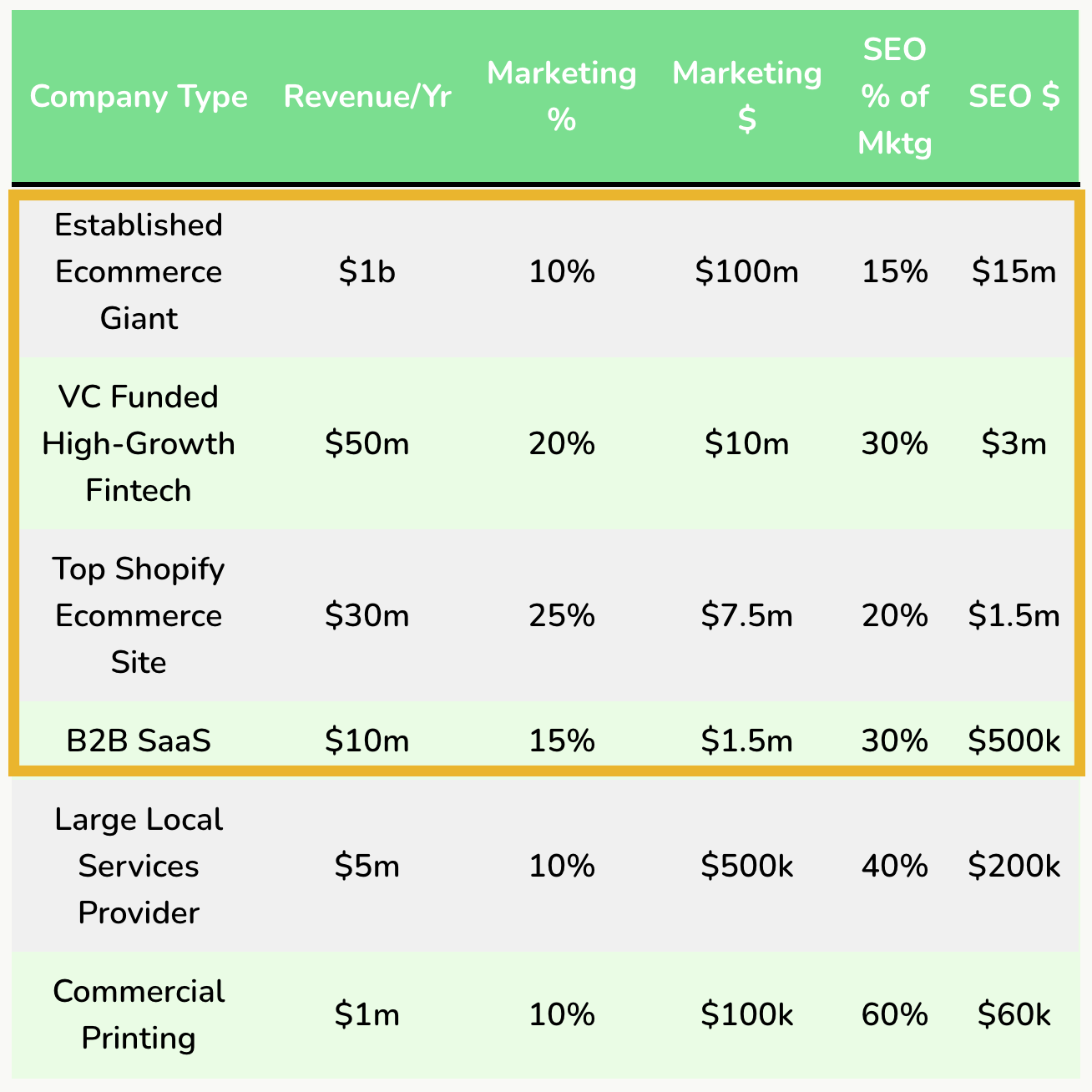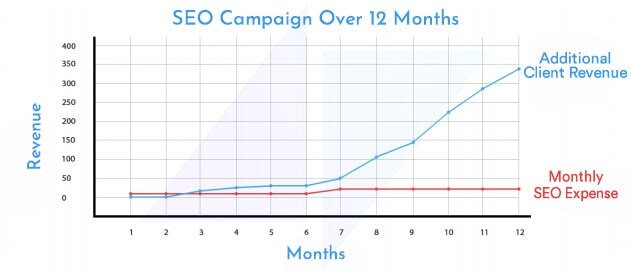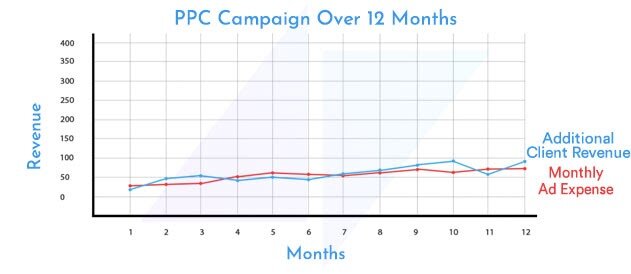TL;DR “You shouldn't be investing $5-7K a month in SEO. If you expect to get results that move your brand to the first page and drive organic channel revenue, you're going to need to pony up way more than that.”
Want more than just a summary? Let's dig deep. As an agency owner, I get a chance to pitch businesses for First Page services on a regular basis. Oftentimes, when tech brands look for outsourced help, they do a request for proposal (RFP) process where a bunch of companies send in proposals. To be perfectly candid, First Page has lost business against companies charging $5K a month for SEO services. And honestly, my.mind.is.blown 🤯. If this is as little as your tech brand is investing in SEO, you're doing it wrong. If you're hiring an SEO agency that's charging $5–$7K for guaranteed results, I'd question what you're getting. If your PPC budget is 10–100x+ your SEO budget, it’s time to rethink your marketing strategy.
I’m going to help you model out an SEO budget that fits into a reasonable spend + ROI for your brand. Then, I'll clearly outline what your SEO proposals should look like from an agency partner so that you’re investing in the right work that’ll get you revenue. Here’s how you do it...
The $5–$7K SEO Retainer: What It Is
If you’re a leader of an online brand and are confused about how much you should invest in SEO, you’ve probably done some online research seeking the advice of what others say the perfect SEO investment is. I did this to check out what advice was being given, and what I found was that the VAST majority of articles discussing “how much you should pay for SEO” are speaking to small-to-medium businesses. These price ranges are $1,000–$5,000 a month, which is reasonable, given the total budget of an SMB to spend on marketing ($5K is probably a very high investment for them, but in this case, it's likely to work). However, this is absolutely not what a tech or SaaS brand should spend a month on SEO. You should be looking at a monthly budget that, at minimum, doubles that. We’ll walk you through some of the math and how your SEO budget might compare to your PPC budget later on.
First, I got my hands on a few $5K SEO pitches from SEO agencies that were sent to marketing colleagues of mine, and this is what they included:
-
A range of different types of audits: Technical SEO analysis/audits such as site health audit, page speed, competitor SEO analysis, content audit, and/or website audit of core landing pages
-
SEO strategy (both on-page + off-page) that could be executed by the agency for additional money, or given to a brand to implement themselves
-
“Getting started in SEO” activities that were not suited for brands that had moved beyond the beginner stage
-
A focus on technical, on-site SEO, but little about long-term content strategy
-
Vague promises, such as “new links” each month, yet no mention of the actual amount of links created
-
Various content strategy activities, such as supporting keyword research or a content calendar
-
Reporting on results
-
Few details about a dedicated team or SEO expert who would be working on the account (because there wasn't one)
The majority of $5K SEO proposals did *not* include:
-
Core strategy work to understand the customer journey, personas, or search intent and how that maps to products and the marketing funnel
-
Complete blog production or strategy, or an integrated approach to SEO/content
-
Guest blogging, HARO posts, or influencer posts to build links
-
Distribution tactics or a budget to get newly optimized or created landing pages and blog posts out further in the world, so that Google sees these pieces of online content as worth linking to (newsletters, paid social ads, and social media help support this)
-
Conversion work — A/B testing of landing pages in SEO, heat maps, chatbots, conversion tracking, CTAs, and more that work to convert the traffic you’re bringing in with SEO
-
Dedicated SEO marketers assigned to your account that have a proven background of SEO positions held and results achieved
Why $5,000 a Month SEO Proposals Don’t Work
While a $5K SEO proposal might be easier for you to swallow as a CEO or VP of Marketing with limited budget or resources to go around, what you’re getting is a very limited, siloed amount of SEO work. And this comes likely without any “bigger picture” strategy or integration into your business or other marketing channels.
This is not an approach I would ever recommend as a marketing leader myself who has grown and led 25-person marketing teams focused on all channels from SEO, content, email, and lead generation to social media, brand, PR, analytics, and more. If you change a few keywords on the home page, update some technical stuff, and optimize your landing pages: sure, you might drive increased traffic or rank higher. But if you care about conversions and increased revenue — and I know you do — the work doesn't stop there.
Instead of looking at just SEO itself, it’s better to think about the result you want: increased qualified traffic, leads, and revenue. So what are the tactics that are going to get you these things? SEO will definitely be one of them. But SEO should never sit outside of a content strategy, and both of them need to work in tandem with an amplification, conversion, and distribution strategy. For example, you might need to put out paid social ads or distribute your content on social or build a newsletter so that more eyes see your content and a groundswell is built (this matters to Google). You also really need to focus on what is happening *on* the page to convert those customers, either through CTAs aligned with your products and the stage of buying they’re in, or with chatbots and a simple newsletter signup box.
This integrated approach to online marketing with SEO at the forefront matters, so you’re not just getting SEO traffic that visits and bounces. You need to bring new users in through SEO and content, then you need to think about the ways that those users are converting on your site when they visit.
As a Leader, How Do I Know What to Spend on SEO?
The above is a question that every founder and marketing leader should be asking when building their marketing team, plan, and budget (every single year). The common channels that Google Analytics tracks in their Acquisition report breakdown as the following:
-
Direct
-
Organic Search
-
Generic Paid Search
-
Branded Paid Search
-
Email
-
Affiliate
-
Social
-
Referral
Each of these are channels that could significantly drive traffic, leads, and conversions to your website. Usually Direct is a bucket that is somewhat inaccurate and kind of a catchall for Google to attribute things they can’t figure out for one reason or another. But, as a brand, your top traffic and revenue drivers are likely going to come from Organic Search and Paid Search, so these are the most important to cultivate and grow.
Many brands know right away that to growth hack and build quickly, you need to invest in bottom-of-the-funnel (BOFU) ads to get people to sign up (such as paid search/PPC or paid social). Online advertising is the quickest way to grow signups and cash and requires very little legwork other than a very smart ad expert to optimize campaigns. However, it’s VERY expensive. And if you stop spending, the return shuts off.
First Page Client Case Study
I’m going to use a client of ours and their paid search vs. organic search spend to show return numbers:
For every dollar spent on PPC ads, you might see 40 percent return (less than 50 percent ROI).
For every dollar spent on organic search, you might see 1,000%+ ROI.
These are real numbers I calculated using 2020–2021 marketing data. Our client invested 60 percent in paid social, and received 40 percent profit from it. And they invested 8 percent in SEO and received 92 percent profit (1,142 percent return).
PPC works, but it is a short-term solution, If you want a long-term strategy to beat your competition and build trust and authority to capture market share, you need killer SEO.
So, How Do You Get Killer SEO?
It all comes back to this: how much should you be spending on that killer SEO? What I know from the dozens of brands I've worked with for the last 10 years is this: you're probably underinvesting and underspending in SEO. Nailing an SEO budget is hard and most of what we do at First Page is custom-based on your actual traffic, revenue, and growth numbers (along with cost of your service/product).
I love this article that talks about how your SEO budget might stack up against your PPC or overall revenue. Of all the articles I’ve found that are giving advice on SEO budgets (that aren’t $5,000 a month), this article is the most in-depth I’ve seen in terms of understanding the entire picture of growth marketing, all of the channels of marketing, and how this ecosystem works together to drive revenue.
I don't want you to bounce though, so I'll sum it up: their general advice is that your marketing budget should be 5–10 percent percent of your revenue, with SEO being a smaller allocation of that, perhaps 25–50 percent. The author also talks about how your SEO spend should stack up against your PPC spend, and he strongly advises against overspending on PPC while underspending on SEO (a tactic 99 percent of the businesses I see employ). This quote from the article’s author is one I would love to frame on the wall of my office because it’s how I also feel:
"At a minimum, you should be spending at least 50 percent of what you’re spending on your PPC budget. A more 'best practice' benchmark would be matching 100 percent of your PPC budget."
From my perspective (and most SEO experts) it’s insanity to spend such a hefty amount on PPC with a disproportionately small SEO budget.
But, the part I love the most from Greenleaf Digital’s article is the graph below, which lays out hypothetical companies, their revenue, and allocation of marketing budgets and SEO budgets. Take special note of the top types of companies he’s highlighting, because these are our customers at First Page (VC funded, high-growth Fintech, tech, or SaaS):

From this graph above, your budget as a tech company looking to invest in SEO would be $41K–$1.25M a month...a far cry from $5,000.
If you think $41K is crazy, I’ve got another way to approach your SEO spend that uses your own current benchmark data to help you create a budget that makes sense.
Use This Exercise of Benchmarks & Projections to Build Your SEO Budget
At First Page, we run some numbers when creating new proposals for potential clients, and then build our plan within the ROI that works. We use a brand’s current organic channel traffic and conversion to then create a projected growth model, so that the investment makes sense financially. Here’s how I do it:
Benchmarking
First, you want to take your benchmarks for your organic channel traffic and conversions today, then find your conversion rate for those numbers. Next, predict your revenue per month from organic channel with conversions, price per service/subscription, or take the actual revenue number from your Google Analytics. Finally, look at your average growth rate for a year (is that 50 percent growth?). Take this number to estimate what your organic channel revenue will be for the next year using your benchmark numbers today. I build this model in a spreadsheet using some basic math. Here is an example with some numbers we see from tech brands we’ve worked with. We’ll call this "Company A."

Projections
Once you have your benchmarks, you can model out what projections would be for an SEO channel investment. With the right budget and the right company behind your progress and growth, you should be able to reach 3–5X traffic growth and a conversion rate between 1–2 percent. Take the benchmark numbers, change the traffic to be ~4X what your benchmark is, and your conversion rate to be ~1.5 percent if it isn’t already (these are easy numbers to achieve with the right partner). This should help you find out how much money would be "left on the table” if you didn’t invest in SEO, but more importantly, how much revenue you could bring in.
Here’s an example of the above benchmarks with projections made for Company A:

Given the outlined benchmarks and projections above with Company A, they would be leaving $251,388 on the table if they did nothing and stayed the course. This tells them they can expect to bring in ~$350,000 in SEO revenue, so an investment under this amount would make sense. If they want to see a 3x return, a ~$10K investment a month would cost them $120K and should return about $350K.
But what’s even better about investing in SEO? The growth rate of what is returned after investment is exponential, unlike PPC budgets that require more spend for more revenue. Conversely, with PPC, when you spend less, you make less. There is no long-term staying power with PPC spend. I love this article that shows the return rate of an SEO campaign vs. a PPC campaign:


And again, a quote I would love to frame on my office wall from this article too:
"The value from search engine optimization compounds over time… So unlike PPC on Google Ads, SEO is not how you make a quick buck. SEO is how you build wealth through a business website."
Therefore, even if Company A wanted to invest their entire projected revenue into SEO ($350K) at ~30K monthly budget, this would still be a long-term investment in their brand and website, and would exponentially return in years to come.
What to Look for in an SEO Proposal
Perhaps you’re not ready to invest $30,000 or $41,000 a month in SEO. But hopefully this article has outlined some numbers that could help you pinpoint a more reasonable place to start than $5,000. Once you’re ready to find a partner that can holistically grow your organic search channel, you need to find a growth agency that can help you launch and manage all of the tactics below to get results. Here's what to look for in the SEO pitch you're receiving:
-
Core strategy work to understand customer journey, personas, or search intent and how that maps to products and the marketing funnel
-
An annual plan that is focused on your brand's growth KPIs (with SEO, not PPC, as the major focus)
-
Ongoing monthly SEO and content strategy
-
Landing page rewrites and optimization
-
Keyword research for head keywords and long-tail keywords (that is consistently reevaluated throughout the year and contract)
-
Technical SEO audits, updates, and monitoring
-
Link building outreach and backlinks using smart techniques such as SEO tools, data-driven content, guest blogs, influencer outreach, HARO pitches, and more
-
Blog strategy, blog production, and minimum 6–10 blogs per month
-
Budget for SEO content writing/tools
-
Paid social budget to boost new landing pages/blogs and build a groundswell of eyeballs and authority to new content and your website
-
Monthly data analysis, reporting fixes, and dashboards
-
A dedicated, expert SEO team to use on both strategy and execution
If you're paying experts who have been working in SEO for 5–10+ years, all of this should cost $10–$15K minimum. If it's $4–$5K a month, my guess is you're getting a cookie-cutter approach by a company that is doing very little custom work or outsourcing it. They are not thinking holistically as an internal branch of your company that can speak to your customers appropriately and convert traffic into dollars. A bare minimum approach that changes keywords and onsite SEO is not going to move your SEO needle to the place you want it to be.
Choosing the Right (Not the Cheapest) SEO Team
Remember: the goal here is to be aggressive, capture *first page* search results, and get money to come in for search terms you want to target without spending $20–$50 per click with PPC advertising. When you start to spend appropriately, you'll see the return in SEO you're looking for, and start to beat out your competition by capturing new customers searching for businesses and products like yours each month. With the right partner, you should see your organic channel traffic climb in Google Analytics. And when this traffic is qualified because you’ve spent time and resources investing in a strategy that speaks to your customer’s buyer’s journey and search intent, this traffic will convert into leads and customers. And your revenue will soar.
Ready to invest? My team is here to take you to the next level — I’d personally love to hear from you.






